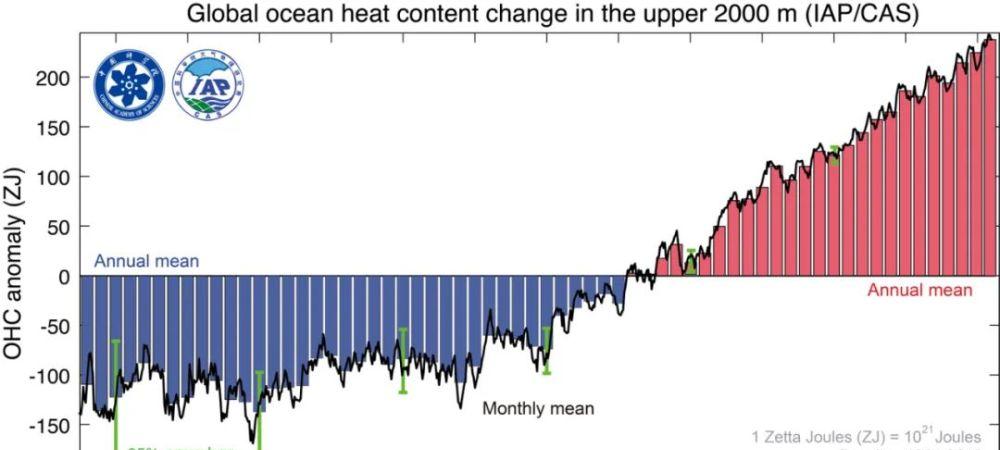◎ Science and Technology Daily reporter Lu Chengkuan
Global ocean warming "double-clicking" broke records! The latest data show that the mediterranean, Atlantic, southern ocean and northern Pacific ocean areas have reached record temperatures.
On January 11, an international research team of 23 scientists from 14 scientific research units around the world, led by the Institute of Atmospheric Physics of the Chinese Academy of Sciences, released the world's first 2021 global warming report on Advances in Atmospheric Science.
The report shows that ocean warming continues in 2021, becoming the warmest year since modern ocean observations have been recorded.

Time series of 2000 m change in heat content in the upper oceans of the world from 1958 to 2021.
Human activities lead to an increase in the concentration of greenhouse gases in the atmosphere, and heat trapping within the climate system leads to an increase in ocean heat. The oceans store more than 90% of the heat of global warming. Ocean temperatures are less affected by natural fluctuations than surface temperatures, making changes in ocean heat content one of the best indicators of global warming.
The latest data from the Institute of Atmospheric Research of the Chinese Academy of Sciences show that the heat absorbed by the 2000 meters of the global ocean layer in 2021 increased by 14× 10^21 (14 times 10 to the 21st power) joules compared to 2020. "This heat is about 500 times the amount of electricity China generates in 2020." Cheng Lijing, an associate researcher at the Institute of Atmospheric Research of the Chinese Academy of Sciences, explained.
Every decade of the past 80 years has been warmer than the previous decade. Warming the oceans has caused a series of daunting consequences, such as rising global sea levels and increasing time for extreme precipitation. In addition, "warm oceans pressurize the weather system, producing stronger storms and typhoons/hurricanes that increase precipitation." At the same time, warmer oceans also lead to warmer, wetter atmospheres, which promote stronger rainfall, which increases the risk of flooding. Cheng Lijing said warming seawater threatens marine ecosystems and human livelihoods, such as coral reefs and fisheries.
The report shows that ocean warming is more intense in the Southern Ocean, the mid- and low-latitude Atlantic, the Northwest Pacific Ocean and other regions. To explore why, the researchers used independent forcing experiments from the National Center for Atmospheric Research's (NCAR) Earth System Model (CESM) to reveal the contribution of different forcing factors to ocean warming. Experiments have shown that the increase in greenhouse gases is the main reason driving the spatial structure of ocean warming, in addition to industrial and biological aerosols, land use, etc. also have a certain impact on ocean warming.
Polar Bear in 2014 (Photo: Wang Shaoqing)
In addition, "the ocean's response to increases in greenhouse gases is slow and lagging, and effects such as ocean warming caused by past carbon emissions will continue for at least hundreds of years." Cheng Lijing said that this phenomenon highlights the important role of the ocean in global climate change.
The research team points out that the impacts of ocean warming need to be fully integrated into climate risk assessments, climate impacts and responses.
At the same time, the study also shows that there are still uncertainties and knowledge gaps in the monitoring of ocean warming, such as the quantification of uncertainty from interannual to multi-year interdecadal scales, the impact of data quality control, and regional differences in heat content revealed by different data sets. Therefore, "a better understanding and understanding of ocean dynamics is fundamental to the fight against climate change." Cheng Lijing stressed.
The research team also released 2021 ocean heat content data from two international institutions, IAP/CAS ocean observation grid data from the Institute of Atmospheric Physics of the Chinese Academy of Sciences, and NCEI grid data from the National Oceanographic Information Center (NOAA/NCEI) of the U.S. Oceanic and Atmospheric Administration.
Source: Science and Technology Daily The pictures in the article are provided by the Institute of Atmospheric Physics of the Chinese Academy of Sciences
Editor: Liu Yiyang
Review: Yue Liang
Final Judge: Liu Haiying